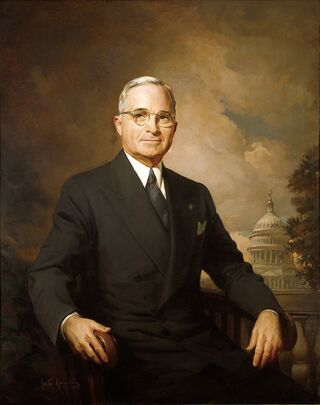Education
A Proposal by President Truman Fulfilled by President Biden
The community college is the key to the future of education
Posted September 20, 2021 Reviewed by Hara Estroff Marano
Key points
- President Biden’s proposal for $109 billion supporting free community college tuition spotlights increased access and opportunity.
- The end of World War II brought dramatic changes to every facet of American life including access to higher education.
- Community colleges now enroll more than half of all college students, from entering freshmen to career-focused adults.
- Partnerships and articulated transfer agreements between community colleges and four-year colleges are poised to grow dramatically.
Luskin Learning Psychology Series No. 59

The end of World War II in 1945 brought dramatic changes to every facet of American life. Millions of men and women had entered military service and saw parts of the world they would never never have seen in peacetime.
The civilian population responded as never before. WWII led to the establishment of defense industries throughout the United States. The labor demands of war-related industries prompted the movement and relocation of huge numbers of Americans throughout the United States.
Mandatory military service, commonly called the draft, caused a nationwide population shift. After the war, the 1944 GI Bill of Rights provided money to help veterans attend college, get jobs, start careers, and buy homes. The Levittown phenomenon, marked by the construction of large, affordable housing tracts, provided homes for young families in what we know as the post-war baby boom (Quigley, 2003).
Since World War II, African Americans, Hispanic Americans, Asian Americans, Pacific Islanders, American women, LGBTQ+, and Caucasian populations vigorously acted to exercise their civil rights, guaranteed by the Declaration of Independence and the U.S. Constitution. In addition, new thinking, investment, technology, and workforce job opportunity boomed, reinforced by new nationwide access to educational opportunities.
Responding to America’s post-war needs.

President Harry Truman appointed a special commission to chart a new course for higher education in America. As a result, Higher Education for American Democracy, commonly referred to as the Truman Commission Report, was published in 1947. It reimagined the role of higher education in American life and has had one of the most historically significant outcomes ever produced by a commission. Its impact on education and culture has been profound.
One of the report’s principal recommendations was that there be a college located within driving distance of every community to provide access to education for every adult American. This fueled the evolution of the American Association of Community Colleges and stimulated the establishment of the American Association of Community College Trustees.
Today, there is a community college within driving distance of every American, serving under the watchful eye of a network of trustees and CEOs overseeing community colleges nationwide. The American Association of Community Colleges reports that more than half of the 20 million adults in college today are attending one of the more than 1,000 American community colleges (Thelin, 2011).
Seventy-five years have passed since the Truman Commission Report.
Finding inspiration in the needs expressed by the Truman Commission Report, President Joe Biden has proposed a plan that takes another dramatic step in the realization of President Truman’s proposal.

Biden has recommended that the federal budget allocate $109 billion to pay for two years of free community college nationwide, so that every adult has the opportunity to obtain a degree, a certificate, or needed education and training. In addition, the Biden proposal states that no person’s future should be determined by their zip code, parent’s income, or race.
The initiatives, known as “The College Promise,” and “Achieving the Dream,” have become rallying vehicles to help fulfill the Truman-Biden vision. Already a cornerstone of American higher education, community colleges presently enroll more than half of all college students, from entering freshmen to career-focused adults. This includes a majority of African American, Latino, Caucasian, and Asian students, most of the low-income, first-generation citizens, older students, veterans, the majority of our college-bound high-school graduates, and adults with special needs (Cohen, A. M., Brawer, F.B., Kisker, C.B. 2014).
Examples of notable community college alumni who have proudly shared their community college stories include:
· Steve Jobs, De Anza, College
· Ross Perot, Texarkana Junior College
· Clint Eastwood and Morgan Freeman, Los Angeles City College
· Tom Hanks, Chabot College
· Nolan Ryan, Alvin Community College
· George Lucas, Modesto Community College
· Robin Williams, College of Marin & Santa Monica College
· Eddie Murphy and Billy Crystal, Nassau Community College
· Arnold Schwarzenegger, Santa Monica College
· Halle Berry, Cuyahoga Community College
· Queen Latifah, Borough of Manhattan Community College
· Debbie Reynolds, Long Beach City College
· Bo Derek, El Camino College
Tuition-free community college means that the freshman/sophomore years are now affordable for all.
The AA degree, as the primary transfer degree, will increasingly serve as an articulated bridge on the way to the BA, the professions, and beyond. There will be an expanding transfer pipeline connecting community colleges and our nation’s more than six thousand accredited four-year colleges and universities. With a community college accessible to everyone, the dramatically increased transfer potential in all of higher education and for all Americans is clear. Articulation transfer agreements between two-year and traditional four-year colleges and universities will grow apace (Cohen, 2014).
The community college is now acknowledged and respected as an accessible, quality educational institution.
For years, community colleges served invisibly in plain sight. President Biden’s announcement of $109 billion in support of free community college tuition shines a bright light on new education, job, and career opportunities accessible to every American. The College Promise will now fulfill President Truman’s vision of a free college located within driving distance of every American. Following congressional approval, all Americans will benefit from new access and opportunity. Community college leaders will respond, true public PK-16 education will be a reality, and individual success stories will abound. The best is yet to come!
###
Contact: BernieLuskin@gmail.com
Special thanks: Toni Luskin, Ph.D., for publishing and editorial support.
References
Cohen, A.M., Brawer, F.B., Kisker, C.B. . (2014). The American Community College (6th ed. Vol. 6). San Francisco Jossey-Bass.
Quigley, S., Bailey, T.W., (2003). Community College Movement in Perspective, Teachers College Responds to the Truman Commission (1 ed. Vol. 1). Lanham Scarecrow Press, Rowman & Littlefield.
Thelin, J.R. (2011). A History of American Higher Education (2nd ed.). Baltimore: The Johns Hopkins Press.
Luskin, Bernard (2019), The American Community College: Invisible in Plain Sight, Psychology Today Blog., Google.




